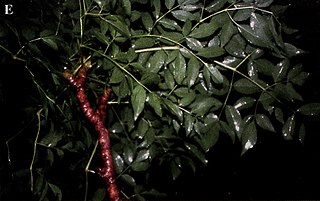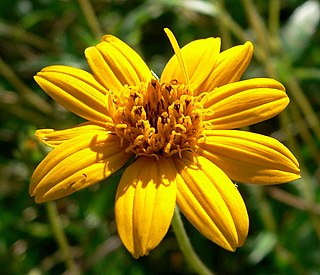Spilanthes is a genus of African and South American plants in the tribe Heliantheae within the family Asteraceae.

The Heliantheae are the third-largest tribe in the sunflower family (Asteraceae). With some 190 genera and nearly 2500 recognized species, only the tribes Senecioneae and Astereae are larger. The name is derived from the genus Helianthus, which is Greek for sun flower. Most genera and species are found in North America and South America. A few genera are pantropical.

Verbesina, many species of which have crownbeard as part of their common names, is a genus of flowering plants, in the family Asteraceae. It is a large genus of about 350 species.

Tillandsia excelsa is a species of flowering plant in the family Bromeliaceae. It is native to Central America, Cuba, Jamaica, and the Dominican Republic.

Aralia excelsa is a species of flowering plant in the family Araliaceae. It is native to Mexico, Central America, northern South America and parts of the Caribbean.
Verbesina mameana is a species of flowering plant in the family Asteraceae. It is found only in Ecuador. Its natural habitat is subtropical or tropical moist montane forests. It is threatened by habitat loss. In the late nineteenth-century a syndicated article appeared in local newspapers citing the American Agriculturalist and praising the ornamental value of its foliage: “A new plant of this class is Verbesina Mameana, of the great Composite family. It was discovered in his South American explorations by Hugo A.C. Poortman in 1883. Poortman's work had been commissioned by Édouard André, who named the new species in honor of M. Mame, one of the promoters of the expedition. It grows at an altitude of four to six thousand feet, in a temperate climate. We have several native species of Verbesina; two of them in the Atlantic States, popularly known as Crownbeard; they grow six feet high, but are coarse and weedy.”

Wedelia is a genus of flowering plants in the family Asteraceae. They are one of the genera commonly called "creeping-oxeyes".

Garcinia aristata is a species of flowering plant in the family Clusiaceae. It is native to Cuba, and possibly Hispaniola and Puerto Rico. It is threatened by habitat loss.
Athyana is a monospecific genus of plant in the family Sapindaceae, containing only Athyana weinmannifolia. It is found in Argentina and Bolivia. It is threatened by habitat loss.
Loxopterygium grisebachii is a species of plant in the family Anacardiaceae. It is found in Argentina and Bolivia. It is threatened by habitat loss.
Tabebuia bibracteolata is a species of flowering plant in the family Bignoniaceae. It is endemic to Cuba.
Tabebuia platyantha is a species of flowering plant in the family Bignoniaceae. It is endemic to Jamaica.
Tabernaemontana wullschlaegelii is a species of flowering plant in the family Apocynaceae. It is endemic to Jamaica.

Tillandsia capitata is a species of flowering plant in the family Bromeliaceae. It is native to Mexico, Honduras, Cuba and the Dominican Republic.
Greigia alborosea is a species of flowering plant in the family Bromeliaceae. This species is endemic to Venezuela.
Tillandsia compacta is a species of flowering plant in the family Bromeliaceae. This species is native to Cuba, Hispaniola, Colombia, Bolivia, Venezuela and Ecuador.

Tillandsia fendleri is a species of flowering plant in the family Bromeliaceae. It is epiphytic. This species is native to the West Indies and South America.
Vriesea robusta is a species of flowering plant in the family Bromeliaceae. This species is native to Venezuela.
Clusia clusioides is species of flowering plant in the family Clusiaceae. It is a small tree which that is native to Puerto Rico and Hispaniola. One characteristic are the opposite, very thick leaves. It is very common in the dwarf or elfin forests at elevations above c. 2,500 feet (760 m), in particular in areas with much light. The gray and smooth bark of the tree is sometimes covered with mosses and other epiphytes including orchids.








